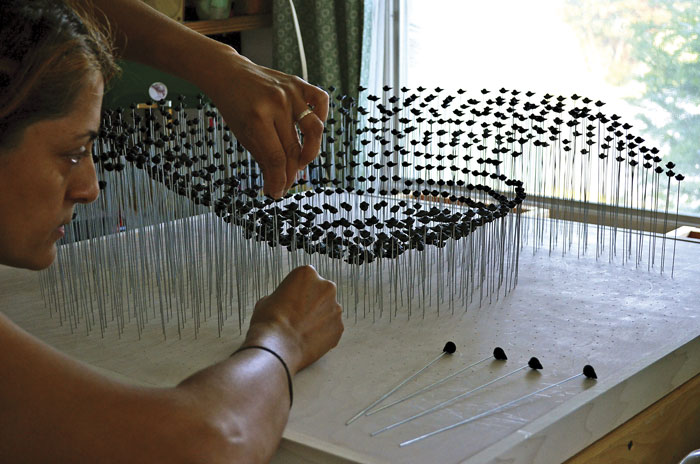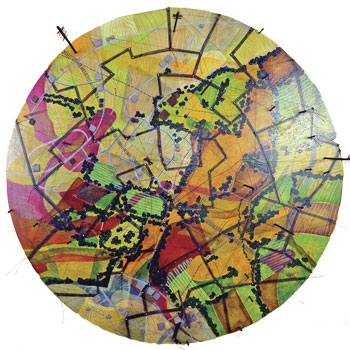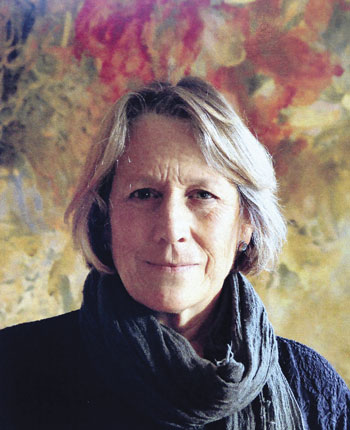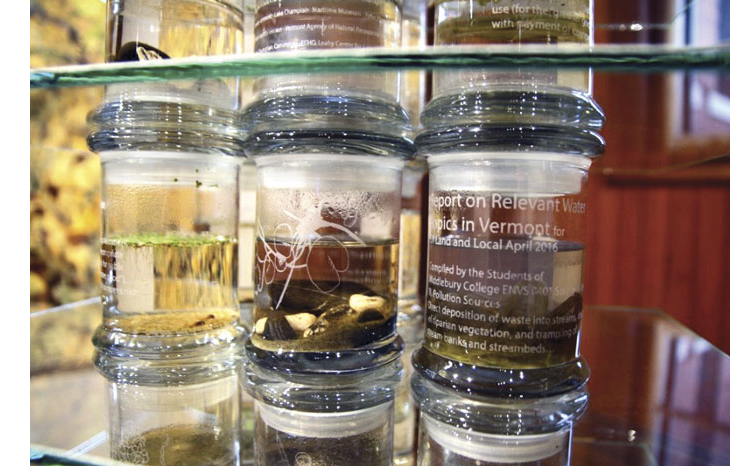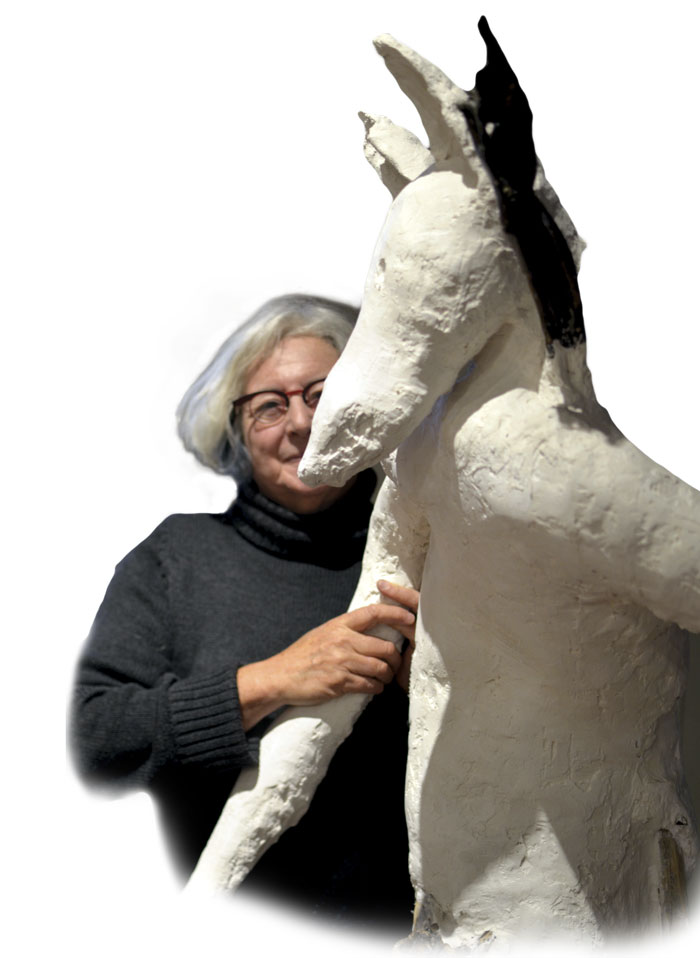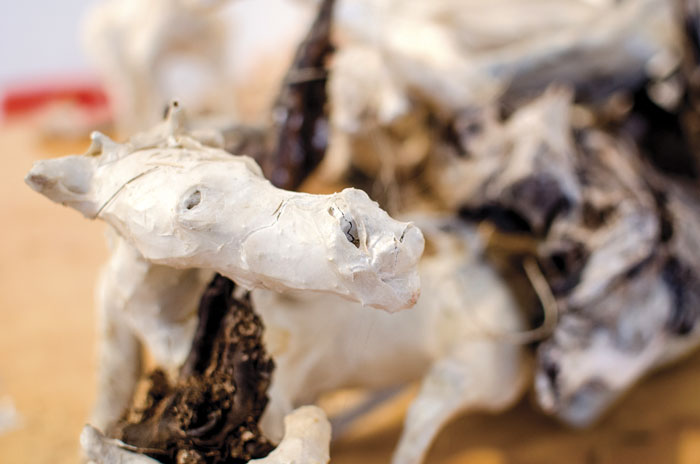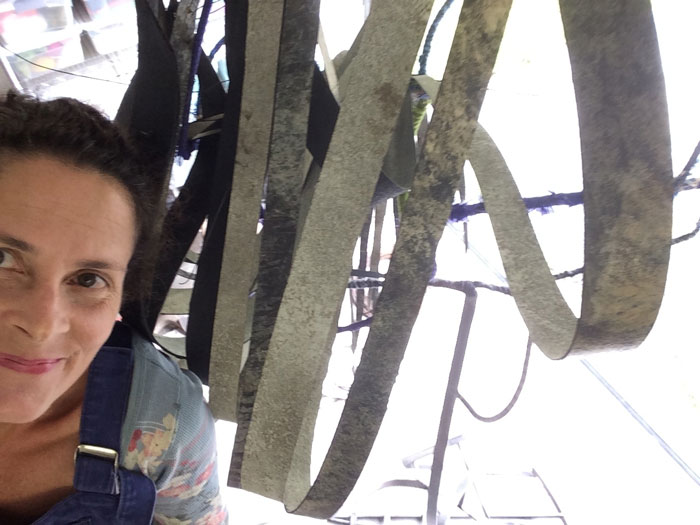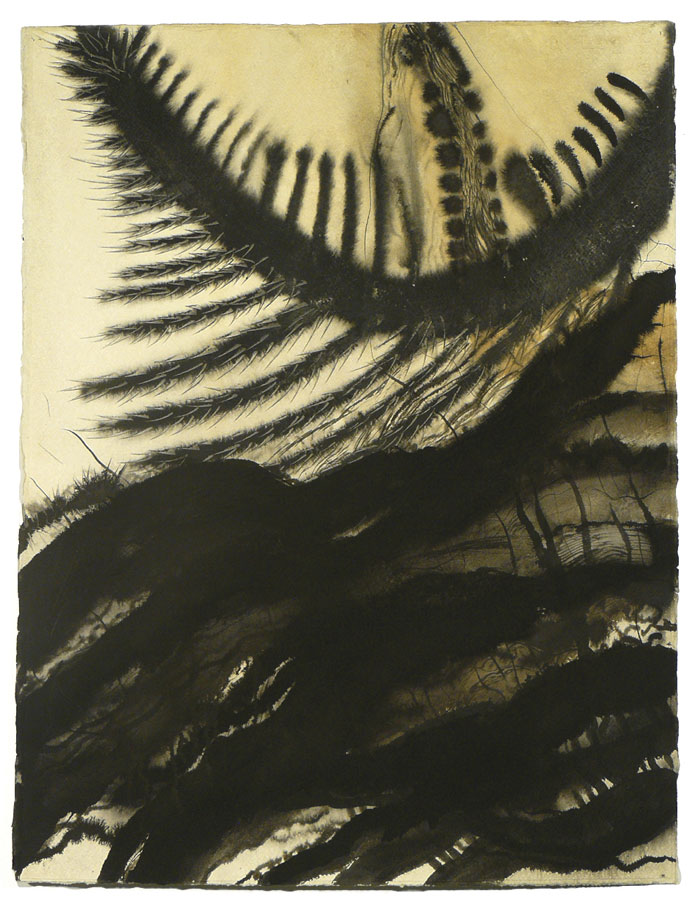| Four Artists Sustained by the Natural World Gowri Savoor, Cami Davis, Riki Moss, Brenda Garand |
|||
| by Cynthia Close | |||
Vermont’s richly varied natural environment, rooted in an agrarian past with an intense concern for a sustainable future, has spawned a wave of artistic expression that goes beyond mimicking nature to embedding the materials, as well as the spirit, of the natural world in the work. In particular, Vermont-based artists Gowri Savoor, Cami Davis, Riki Moss, and Brenda Garand are all actively producing genre-bending art that transcends borders and challenges how we think about the world we live in. Each of these artists has had work featured in the annual Of Land and Local exhibition, a collaborative project curated by Burlington City Arts (BCA) and supported by Shelburne Farms and a number of other cultural institutions across the state. The primary goal of this multidisciplinary, statewide exhibition is to “initiate a dialog about issues surrounding art and the environment that relates to the Vermont landscape.” In some cases throughout the months preceding the exhibition, the participating artists spend time in residence doing work on location, responding in very direct and specific ways to their chosen site. The results of each artist’s investigations are exhibited both at the BCA and at Shelburne Farms, usually in the fall near the height of the harvest season when we can reap artistic rewards as well as the agricultural kind. |
|||
|
Gowri Savoor, the youngest of the four artists featured here and also the most recent resident of Vermont, was born in Leicester, England, in 1972. She came to the United States in 2007, bringing her heritage with her, in the form of the Indian art of rangoli. This ephemeral form of public art making is practiced throughout India. It’s comparable to Navajo sand painting and other dry-painting techniques practiced by Tibetan and Buddhist monks, as well as by Australian Aborigines. Geometric designs are drawn on the ground and then filled in with colored powder and embellished with sand, candles, or flower petals. While collaboration is at the heart of Savoor’s teaching, as an artist she works alone in her studio making more personal statements. Process is essential to the individual environmental sculptures she creates, using hundreds if not thousands of apple, sunflower, black locust, pine, ash, and maple seeds. Each seed is painstakingly and delicately suspended on a steel or wire pin, the seeds forming swarms, illustrating, in Savoor’s words, “the unstoppable progression through cycles of decay and creation.” Although these sculptures are exhibited as three-dimensional objects that can be purchased, their ephemeral qualities are part of Savoor’s conceptual framework of embracing nature’s impermanence and change. |
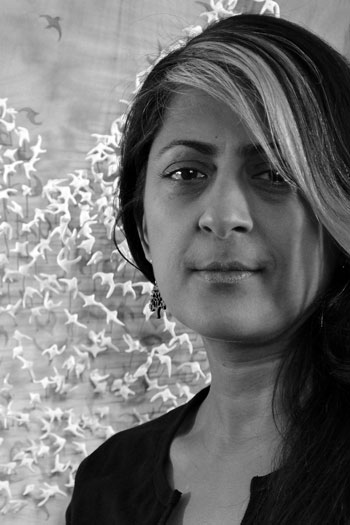 |
||
| Teaching, environmentalism, and community work form the core of Savoor’s artistic engagement. She is impressively prolific. Savoor cites the support she has received from the Vermont Arts Council’s Arts Connect Program as essential to her survival as a teaching artist. Among her projects is creating paper lanterns, which she produces in concert with organizations across the state as a celebratory and communal act. These lantern celebrations can be viewed on a newly launched segment of her website: www.ariveroflight.org. | |||
Gowri Savoor at work on one of her Murmurations, made with polymer clay steel and wood. |
|||
Gowri Savoor, Time Missing, mixed media on wood (2016)
|
|||
|
|||
Davis was raised a Catholic but was educated in part by a "radical group of intellectual nuns." She now declares she is "not religious, but spiritual," and her spirituality is reinforced by her deep investigations of the natural world. In 1976 she received her BA in studio art from the University of Vermont and later, in 1981, an MFA in painting from Pratt Institute. Her studio practice has always run parallel to her interests in ecological thinking, which she studied at Schumacher College in Devon, UK, in 1998 and again in 2015. She is currently a senior lecturer in the Department of Art and Art History at UVM. Davis's installations in the 2016 Of Land and Local: Watershed consisted of clear glass apothecary jars filled with water samples and flotsam and jetsam taken from various locations in and around Lake Champlain. Each jar was etched with poetic or place-related words and contained a whole system. Davis describes these magical jars as "little worlds unto themselves" showing the "rich particulars of place." But they are also "little, anxiety-producing jails" because, as Davis notes, "the lake is really scary right now, given the levels of cyanobacteria"—among other pollutants that affect the health of everything that comes in contact with the water.
Cami Davis's Of Land and Local 2016 installation of water-filled apothecary jars. Davis collected over 1,000 jars. Of those, 120 were displayed at Shelburne Farms and 300 were arranged in stacked rows in front of the glass wall at the rear of the BCA, allowing the light to filter through. The effect was intriguing as there was clearly life evolving in these "little worlds." For this reason, the jars were not sealed, or they might have exploded. On the wall adjacent to the jars hung a large, luminous painting in rich earth tones, gold, and swirling shades of green that seemed as alive as the specimens in the jars. |
|||
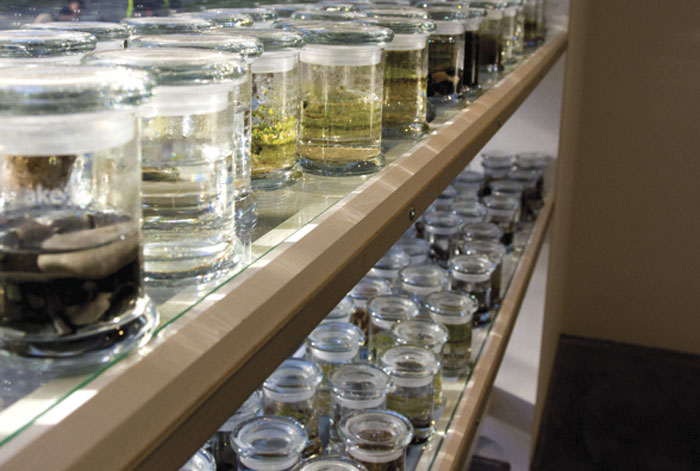 |
|||
Davis's paintings are, on some level, like an antidote to the anxiety many feel about global climate change. During our interview for this article, she referenced the philosophy of Joanna Macy, who coined the concept of the Great Turning, which states the belief that we have reached an environmental tipping point and are in a period of transition, on the path to making a life-sustaining society. Clearly the art of Cami Davis is part of this transition.
|
|||
|
Riki Moss is a published author as well as a visual artist creating ceramics, sculpture, installations, and paintings. Born and raised in Brooklyn, New York, she received a BA from the University of Chicago and an MFA from the Vermont College of Fine Arts. She has exhibited widely here and abroad and currently lives in a converted former train station, set on a hill in Grand Isle, Vermont, and works in her light-filled studio next door.
Moss, as with the other artists featured here, has felt the impact of place most directly upon her thinking as an artist. For 12 years she lived at Brickbottom in Somerville, Massachusetts, one of the country’s oldest artist communities whose converted industrial building is zoned for live-work space. Made up of 150 condominiums occupied by artist owners, Brickbottom, located in a densely packed urban environment, is a distinct contrast to the comparative isolation that Moss works in today. Ironically, Moss indicated she has experienced a greater sense of community and mutual support here in Vermont. Moss the writer influences Moss the sculptor. "Words are in the air, and I capture them in the work," she says. There is a respect for the "vagaries of accident," which this artist has embraced, particularly when creating the mystical, mythologically inspired creatures that she forms in response to specific sites. Under the all-encompassing title Parade, Moss has assembled a cadre of over 40 creatures made from bits of driftwood, roots, twigs, and wire that serve as an armature for the abaca paper "skin" she makes, along with her partner, Robert Ostermeyer. This material is manufactured from a banana plant harvested in the Philippines. The pulp is beaten for seven hours before it is turned into sheets, retaining some of the imperfections that reflect its source in nature. The color is a creamy ivory, which perfectly melds with the earthy tones of the pieces of debris used to form the limbs and other body parts that intuitively animate these fantastical beings.
Recent political actions concerning immigration have triggered new associations for Moss. She sees a connection between the movement of her figures and that of the refugees: bodies, both human and animal, are moving in waves we don't fully understand. While some are heading for extinction, others are evolving into new forms. Moss is now preparing an installation for an exhibition in Boston titled Peace: Cutting Through Turmoil. Her work will focus on the theme of home—what it means to find safety and security in a particular place. She will be constructing the piece out of the natural stuff found in the woods near her home on Grand Isle, such as driftwood and stones from Lake Champlain, as well as a small house constructed from balsa wood, carpenters' scraps, and mango seeds. How it will all look in the end will depend on how Moss responds to the actual site when she installs the work in June. The exhibition will be open for viewing until July 1 at the Brickbottom Artist Building in Somerville, Massachusetts.
|
|||
|
Brenda Garand has experienced the massive destructive power of nature first hand. Her home and studio were destroyed in 2011 by Hurricane Irene and had to be gutted. When the waters finally receded, they left behind a thick coating of clay that stuck to everything. In the gradual process of cleaning up, she saved some of the clay in coffee cans.
It took time before Garand was able to make art again, but like a phoenix rising from the ashes, she ultimately used this clay, mixed with walnut ink and India ink, to create a series of drawings appropriately titled Deluge, which appeared in the 2016 Of Land and Local: Watershed exhibition at Shelburne Farms. These drawings, while abstract, are imbued with a great sensuality. Using bleeding effects when ink is applied to wet watercolor paper to great advantage, the viewer experiences a sense of drowning, as light filters through murky water full of strands of weeds and grasses, waving and bubbling, as the water closes in. Perhaps these drawings were a vehicle for the artist to gain control again of her environment, even knowing such control is an illusion. Garand was raised on a small family farm in Hancock, New Hampshire. She is one of seven children with a twin sister who is also an artist, a printmaker. Her father was a shepherd. She was one of those children destined to make art and knew it from an early age. Her memories of observing the rocks and open fields, combined with a confidence in using tools, was grounded in her early years on the farm. Her parents did not dissuade her when she declared she was going off to college to study sculpture, eventually earning a BFA in 1981 from the University of New Hampshire and an MFA from Queens College of the City University of New York in 1983. Garand had her first sculpture exhibition in Brooklyn in 1984 and has exhibited widely ever since. She has received two Fulbright grants, a Vermont Council on the Arts Creation Grant, and many other awards. Garand has produced work while under the auspices numerous prestigious residencies, including Yaddo, Ragdale, and Atelier Silex in Quebec.
For the past 21 years she has been a professor of studio art at Dartmouth College and is known primarily for her welded sculptural work. Garand has recently been invited to create a piece for an exhibition titled Home Is Where the Heart Is. The theme is in response to a large dollhouse recovered from a home that was severely damaged by Hurricane Sandy. The show will take place in a gallery in Red Hook, Brooklyn, and will open on Saturday, April 29, remaining until Sunday June 4, 2017 The forces of nature continued to impact Garand as she worked through the winter at her home studio in Hartford, Vermont, and like the rest of us, she is looking forward to warmer weather.
|
|||
|
Cynthia Close is a contributing editor for Documentary Magazine, art editor for the literary journal Mud Season Review, and an advisor to the Vermont International Film Festival. She lives in Burlington, Vermont.
|
||
